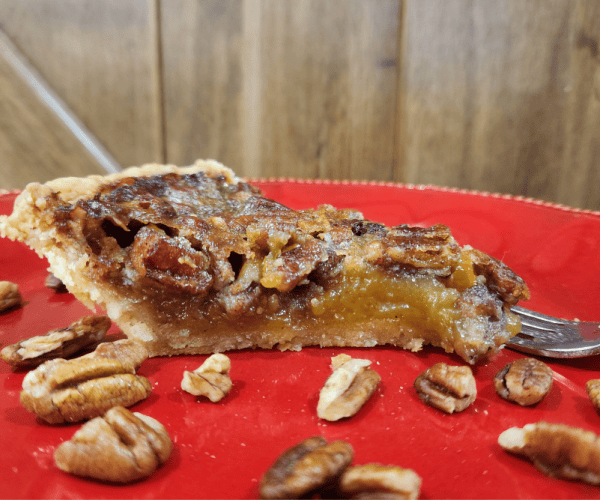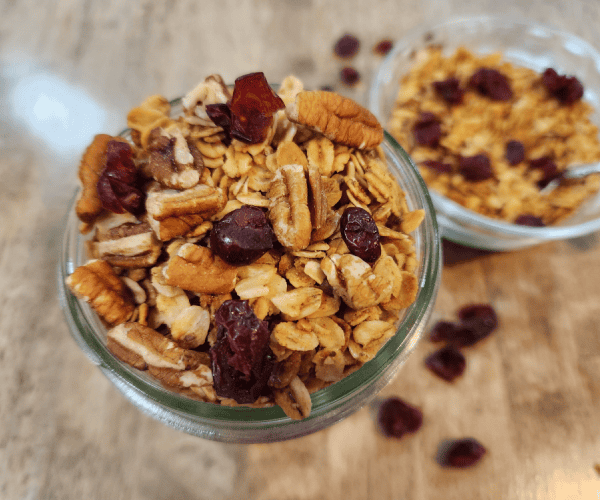When my firstborn was born, I remember being struck at how ancient the process felt. As sterilized and streamlined as we want to make everything, birth is still a raw and almost violent struggle. And maybe that is one of the reasons that farm life keeps one so grounded. The struggle for life is so apparent in the day to day with farming.
With calving season in full swing we have been experiencing plenty of new life. How beautiful it is to see the first steps of a newborn calf.
And yet, it doesn’t always go well. Sometimes a new mom walks away from her first calf. Or you witness a calf born too soon to live on the outside. Last week, we lost a calf when it was born quickly and mom didn’t clean the calf so it would start breathing on its own. For some reason, new mom gave birth and then walked away from her natural instinct to get her baby out of its birth sac by cleaning it. Or perhaps the calf was stillborn. A deep loss.
We also experienced what it felt like to grab a little one and his momma back from the clutches of death and rescue them both. You can read our true calving story down below of rescuing Lucky the calf!
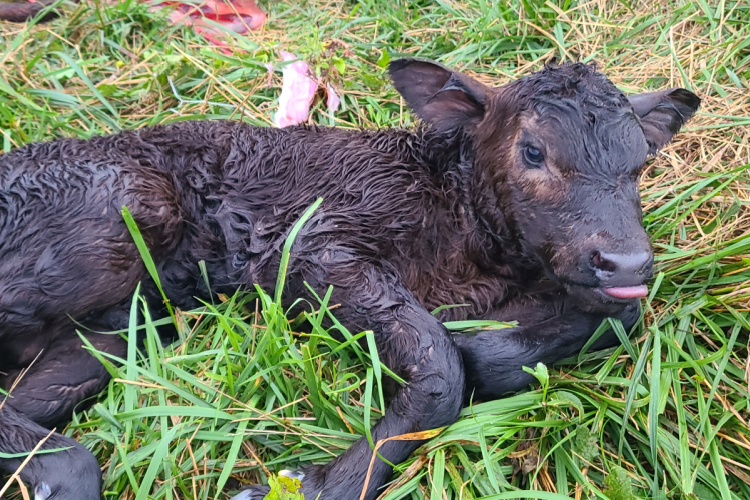
How to Assist With Calving
But if you are here just to glean more information on how to help a cow or heifer give birth, here are some tips we have learned raising cattle.
Typical Post Calving Problems
- Most Angus and Charolais cows or heifers will NOT need your assistance to birth a calf. They will be able to give birth, clean their baby and start nursing their calf on their own. You will want to keep an eye but you will not need to assist in calving. Each breed is slightly different, so be sure to research your breed.
- If a momma cow needs assistance it is typically in caring for the new calf AFTER birth, which I will cover in more detail in another post. In our experience it is a rare occurrence to step in and help pull the calf from the birth canal less than 2%. So while it is super important to be prepared, the chances of having to deliver the calf is thankfully slim.
Assisting with Calving
As mentioned above, assisting with calving where you have to deliver the calf is rare. But you want to be prepared to do so at any time as things can move pretty fast during calving season.
- Develop a relationship with a local vet you trust. Being able to call your local vet and problem solve over the phone is invaluable. Sometimes you may need your vet to come to you, but typically you just need some advice or confirmation of what you have already surmised. In the situation below, we were able to talk to our vet but they couldn’t get to us in time.
- Keep several tools on hand to assist with calving. We have found that you want to have several clean towels on hand in case you need to clean calf of afterbirth. With this heifer, she was too exhausted to clean baby after giving birth. Cleaning and drying the calf was up to us. The weather can get cool in the evenings, whether you calf in spring or fall. So you want to make sure the calf is completely dry once it is born. You will also want a bottle of warm water and a high quality colostrum replacer ready.
- Birthing chains really do help. In assisting the heifer, we had a heifer that was in pain , nervous and sometimes on the move. There was no way to hold onto and assist in pulling the calf out without a good grip. The front hoofs were extended out of the birthing canal, but they were super slippery. We were able to get the chains around each hoof and keep a solid grip.

Calving Season Tools
During calving season, it is good to have some general tools already on hand so that you are ready. Things move really quick during calving season and minutes count. So make sure to gather your calving season tools beforehand.
- Farm Tags and Tagger Applicator. When your calf is just born is the best time to put a tag in its ear. This helped to identify that it is your calf. And if you keep records, this also helps to record who the mom of the calf is. When your calf is born they are much easier to catch. But do be careful of your momma cows as they are very protective! We use this one tag and one tag application tagger.
- Towels. Keep clean towels on hand. When a calf is born, especially to a heifer, the mom may be slow to get her calf dry enough. If the calf is born on a cold or wet day, you may need to dry off the calf, to keep them warm enough.
- Calving Bottles. If the momma cow struggled to give birth or is a heifer, you may have to give the first bottle. So you will want to have a calf bottle like this one. Sometimes it takes a heifer a minutes to understand that the baby calf is hers. She may have the calf and then wander off. If she does not come back to check on her baby in an hour, you’ll want to give the calf a bottle. Most of the times, the new mom will come back. And since the baby will have had the boost of a warm bottle, they will be able to stand up and insist on nursing. So having a calf bottle is a must!
- Colostrum Mix. With the first feeding, the calf receives essential colostrum milk from their mom. So if you have to supplement the baby on the first bottle, you’ll want to use this Calf Colostrum Mix. It is pricey, but it really does set your calf up for life to get all these special nutrients. So make sure that first bottle is colostrum mix.
- Birthing Chains. As I mentioned above, we have only had to use the birthing chains once. But when you need them, you really need them. If you plan on raising cattle, you’ll want to have a set of birthing chains because the vet often cannot get to you in time.
Steps to Helping a Cow or Heifer Give Birth
- Wait til the expecting cow or heifer will allow you to get near enough to help. Keep checking on the momma cow, but realize there is a fine line between stressing momma out by getting too close and her being ready for help. After several hours of being in labor, the heifer was ready to allow us to get right next to her.
- Use the birthing chains to grip the hoofs. You will need to pull on one hoof and then the next to pull the head and shoulders free. Use a downward motion. We also tried to watch and work with her natural contractions so that we were working with her. This took more than a few tries. We worked with her for possibly an hour trying to get her calf free.
- Clear the airways. The momma heifer was laying on her side and her calf was halfway out, but still not free. The calf started to try to breathe so we cleared its mouth and nose of the amniotic fluid.
- Be prepared to dry and feed the calf. Calf was finally free and towel dried. But momma was exhausted and could not feed calf. We had brought a bottle full of warm water. And we had a bag of powdered colostrum that we added to the bottle and then fed to the calf. This gave the calf some food, strength and warmth plus the valuable antibodies of colostrum. Getting Colostrum in the calf as soon as possible (preferably the first hour after birth) is super important and will have lifelong affects on the calf’s health but more on that later.
Our True Calving Story of Saving Lucky
If you are just here for the story, this is what happened!!
Last week, a new mom (a heifer) was showing signs of labor. So we backed away, checking on her several times, allowing her and her body to fight to bring her newborn calf into the world. But as the hours dragged on, we could see that momma was struggling.
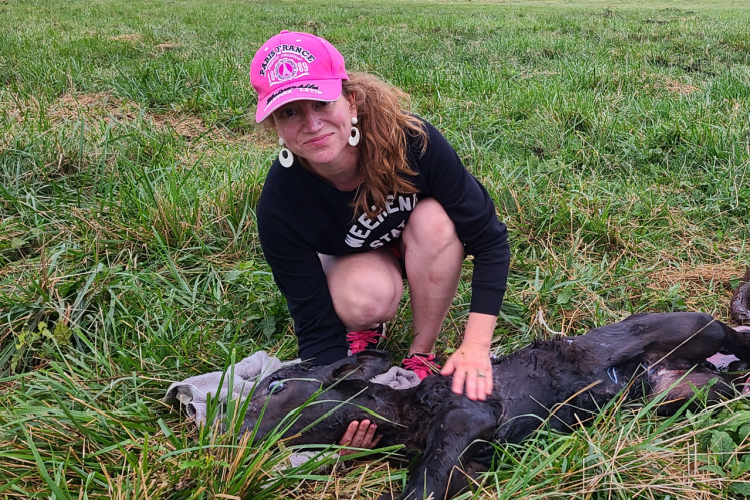
The afternoon wore on and still there was little progress. By afternoon, we could see that the mom was in full labor but only the tips of the front hoofs were showing. We decided to approach the momma cow to see if we could assist her. But she would only jump up and run away from us. My husband and I could only wait.
Matt called the vet and had it confirmed that we simply had to wait til momma cow delivered or was ready to allow us to help her. And we also learned that the vet was hours away so it was on us to do our best.
We took in a quick dinner and came back to the field. As we approached momma she remained laying down. Exhausted from laboring for hours, mom was finally ready for help…or at least too tired to care. Thankfully, we were able to see the hoofs protruding. Matt was able to get the birthing chains around the protruding hoofs.
Suddenly, momma cow decided she didn’t want our help and jumped up to move away. Matt raced to follow her, trying to use the natural momentum of mom moving to start working the calf free. This was exhausting for both cowboy and cow, so thankfully she laid back down.
We were able to get both chains attached to the hooves, to try to pull the calf out further by working the legs and shoulder free. But baby was still not slipping free. With Matt pulling, mom contracting and me yelling like some crazy labor coach, “She’s contracting, pull, pull!!!” we all fought hard.
At this point, momma was fine with all the help she could get so I moved closer and tried to grab a handle on the other hoof. At that point, one of the chains had come off. Slippery with birthing fluid the hoof kept sliding through my hand. I grabbed a towel and wrapped around the hoof. Counting together, Matt and I would pull on 3.
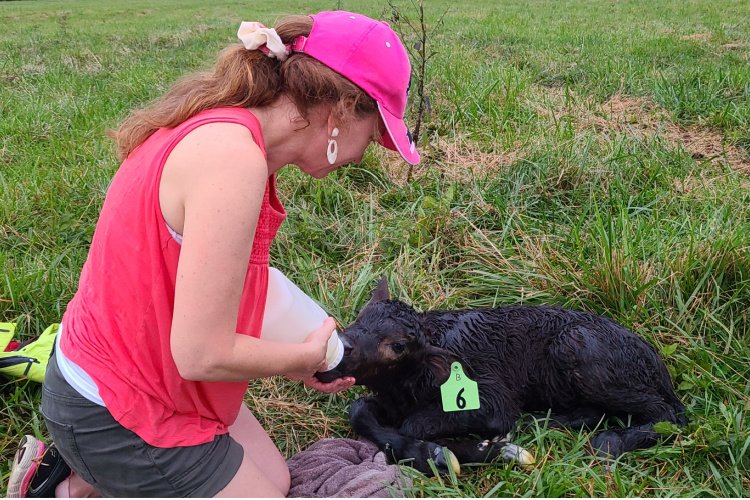
The calf’s head appeared and half of it’s body struggled free. Matt could hear the calf snort to try to breathe. “Clear its nose! Get all the sac out of its mouth!”, he yelled. I rushed to grab a towel and my hands to wipe the little ones mouth free.
Elation hit me for a minute. But I could feel time slipping away and death was creeping closer. We were desperate. The calf was still half in and half out. Mom was hardly moving and yet the calf was still partially pinned inside. Typically, by now most calves would literally have easily slid the rest of the way out of the birth canal. But for some reason this calf was not.
Matt kept pulling and I kept talking to the momma cow trying to encourage her to keep pushing. FINALLY! The calf came free!
We were so happy!! Calf was breathing and moving his little head. He did not get up, but we decided that was probably normal due to the long birth.
Momma cow was not moving at all. For a minute, we were worried that she hadn’t made it. But she had just fallen into a deep rest. So we backed away from her and focused on her calf as she was in no shape to nurse.
We towel dried the calf as best as we could, making sure his nose and throat was completely clear. We already had a bottle full of hot water ready to go. We added a bag of special feed called colostrum that is only meant for the first feeding or two of a newborn calf. It has all the nutrients that will help a newborn calf fight any infection and thrive.
Our newborn calf, nicknamed, “Lucky” was quick to guzzle his bottle and was a perfect bottle baby for us. We did have to stop him a time or two as he wanted to drink without taking a breath!
Afterward, we moved the calf up close to his momma and left. The evening was a pleasant temperature so we knew that baby, now that he was mostly dry, would be Ok. We wanted to give them an opportunity to bond and for mom to rest without the stress of having us nearby.

First thing the next day, we checked on them. They were BOTH up and moving!! Yay! Lucky looked like he had been given a thorough bath by his momma as he was a nice chocolate brown by now and fuzzy looking. Mom and baby were sticking close to each other.
We ended up giving Lucky one more bottle as it still appeared as if his mom’s milk had not come in. He finished it quickly! Later, we tried to give another bottle but he only fooled around a minute with the bottle and then was disinterested. His mom came over, slightly upset that we were near her baby.
Her milk still didn’t appear do have come in, as her udder did not look full. But over the next few days we noticed that she just seems to have a lower milk count. Since we could see Lucky nursing and hear him swallowing, we decided he is getting enough that he is not hungry.
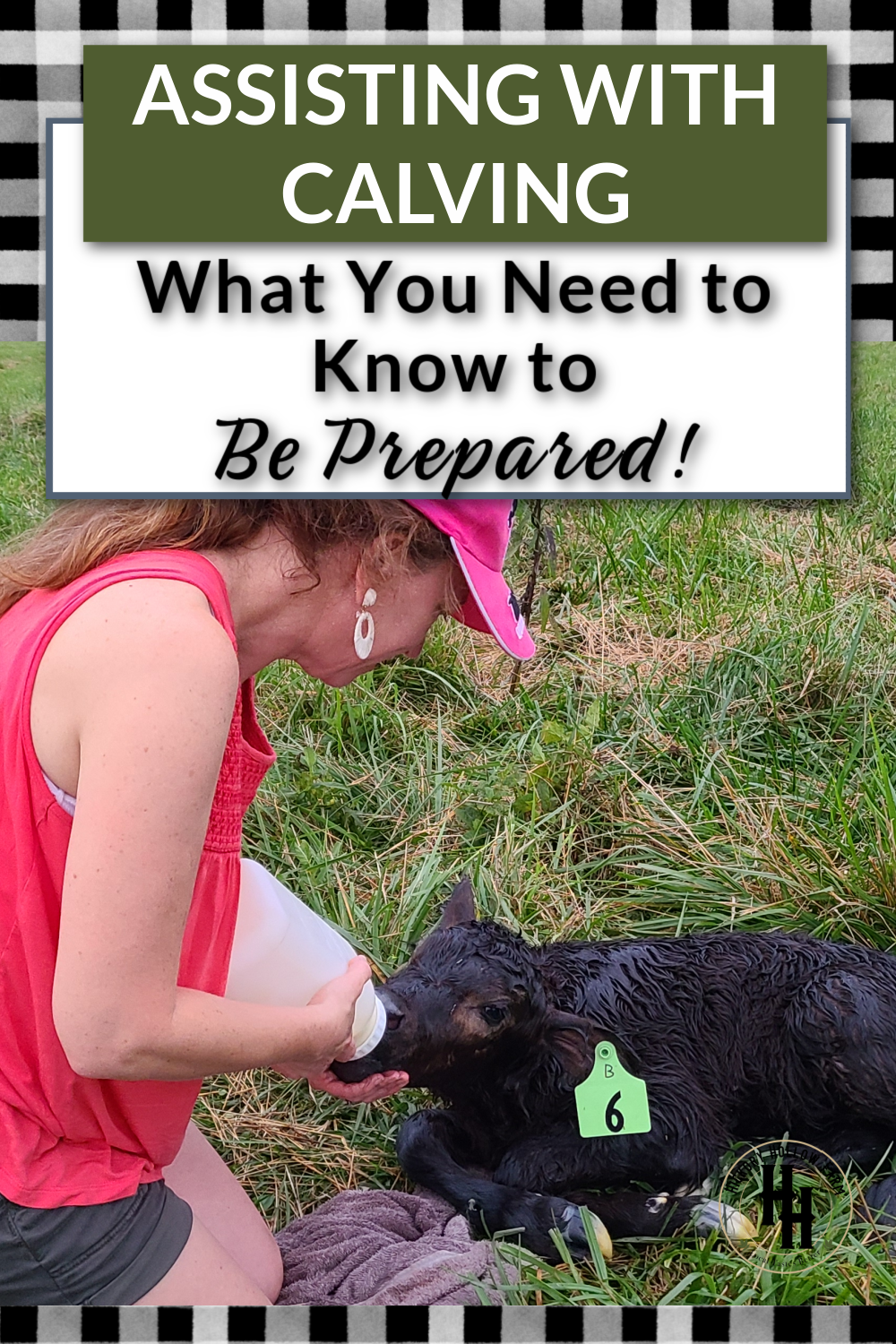
Thankful for the positive outcome for momma and baby. And I’m glad that most of the time the cows don’t need too much help from us!


